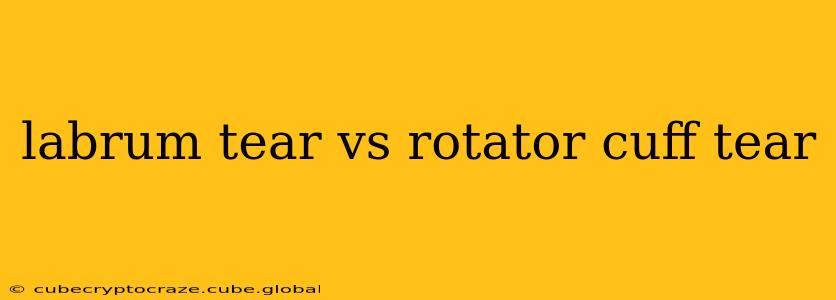Shoulder pain is a common complaint, often stemming from injuries to the labrum or rotator cuff. While both structures are crucial for shoulder stability and function, they are distinct, and their injuries present differently. This article clarifies the key differences between labrum tears and rotator cuff tears, helping you understand the nuances of these conditions. We'll explore their causes, symptoms, diagnosis, and treatment options, addressing common questions along the way.
What is a Labrum Tear?
The labrum is a ring of cartilage that surrounds the glenoid, the shallow socket of your shoulder joint. It deepens the socket, providing stability and helping to keep the humeral head (the ball of your upper arm bone) in place. A labrum tear occurs when this cartilage is damaged, often due to a sudden injury or repetitive stress.
Types of Labrum Tears:
Labrum tears can be classified in several ways, including:
- SLAP Lesion: A superior labrum anterior to posterior (SLAP) lesion affects the top part of the labrum, often involving the biceps tendon attachment.
- Bankart Lesion: This tear is located in the anterior (front) part of the labrum and frequently occurs alongside shoulder dislocations.
- Other Tears: Tears can also occur in other locations around the labrum, causing varying degrees of instability and pain.
What is a Rotator Cuff Tear?
The rotator cuff is a group of four muscles and their tendons that surround the shoulder joint. These muscles (supraspinatus, infraspinatus, teres minor, and subscapularis) work together to stabilize the shoulder, allowing for a wide range of motion. A rotator cuff tear occurs when one or more of these tendons are torn, usually due to overuse, aging, or a sudden injury.
Types of Rotator Cuff Tears:
Rotator cuff tears can range in severity:
- Partial Tear: Only a portion of the tendon is torn.
- Full-Thickness Tear: The tendon is completely torn through.
- Small vs. Large Tears: The size of the tear significantly impacts symptoms and treatment options.
Labrum Tear vs. Rotator Cuff Tear: Key Differences
While both conditions can cause shoulder pain, several key differences exist:
| Feature | Labrum Tear | Rotator Cuff Tear |
|---|---|---|
| Primary Issue | Cartilage damage around the shoulder socket | Tendon damage in the rotator cuff muscles |
| Common Cause | Sudden injury, repetitive overhead motions | Overuse, aging, sudden injury |
| Pain Location | Often deep, aching pain in the shoulder joint | Pain can radiate down the arm, weakness |
| Symptoms | Clicking, popping, instability, catching | Weakness, pain with movement, limited ROM |
| Diagnosis | MRI, physical exam | MRI, physical exam |
What are the symptoms of a labrum tear?
H2: What are the symptoms of a labrum tear?
Symptoms of a labrum tear can vary depending on the location and severity of the tear. Common symptoms include a deep ache in the shoulder, a feeling of instability or "giving way" of the shoulder, clicking or popping sensations, and catching during movement. Pain can be exacerbated by specific activities, such as overhead reaching or throwing.
What are the symptoms of a rotator cuff tear?
H2: What are the symptoms of a rotator cuff tear?
Rotator cuff tears often present with pain, particularly when lifting or reaching. Patients may experience weakness, difficulty sleeping on the affected side, and limited range of motion. The pain can radiate down the arm, and there may be noticeable clicking or creaking sounds during shoulder movement.
How are labrum tears and rotator cuff tears diagnosed?
H2: How are labrum tears and rotator cuff tears diagnosed?
Diagnosis typically involves a thorough physical examination by a physician, assessing range of motion, strength, and identifying specific areas of tenderness. Imaging techniques, such as MRI scans, are crucial to visualize the damaged tissues and determine the extent of the tear.
What is the treatment for a labrum tear?
H2: What is the treatment for a labrum tear?
Treatment options for labrum tears vary depending on the severity and individual circumstances. Non-surgical management, including physical therapy, medication (anti-inflammatory drugs), and rest, is often the first line of defense. Surgical repair may be necessary for significant tears or instability.
What is the treatment for a rotator cuff tear?
H2: What is the treatment for a rotator cuff tear?
Similar to labrum tears, rotator cuff tears are often treated initially with conservative methods, including physical therapy, rest, ice, and anti-inflammatory medications. Surgical intervention might be considered if conservative management fails to provide adequate relief or for larger tears.
Conclusion
Understanding the distinctions between labrum and rotator cuff tears is critical for accurate diagnosis and appropriate treatment. While both conditions can cause debilitating shoulder pain, their underlying causes, symptom presentation, and treatment strategies differ considerably. Seeking professional medical evaluation is essential for proper diagnosis and a personalized treatment plan. Remember, this information is for educational purposes and should not replace the advice of a qualified medical professional.
